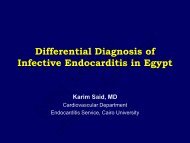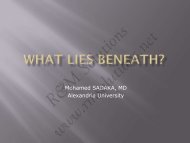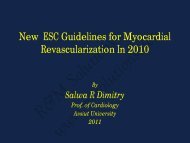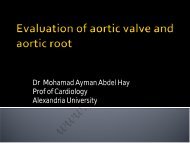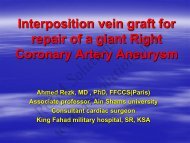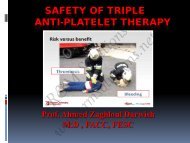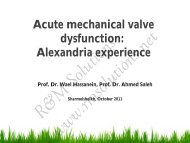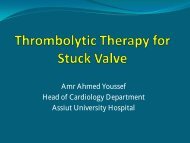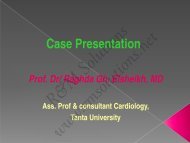Management of Hypertension in Patients with CAD - cardioegypt2011
Management of Hypertension in Patients with CAD - cardioegypt2011
Management of Hypertension in Patients with CAD - cardioegypt2011
Create successful ePaper yourself
Turn your PDF publications into a flip-book with our unique Google optimized e-Paper software.
<strong>Management</strong> <strong>of</strong><br />
<strong>Hypertension</strong> <strong>in</strong> <strong>Patients</strong><br />
<strong>with</strong> <strong>CAD</strong><br />
M. Mohsen Ibrahim, MD<br />
Cardiac Department- Cairo University<br />
R&M Solutions<br />
www.rmsolutions.net
1. What is the hypertesion –<strong>CAD</strong><br />
connection <br />
2. What is the optimal BP <strong>in</strong> patients<br />
<strong>with</strong> hypertension and <strong>CAD</strong><br />
3. What is the m<strong>in</strong>imum safe level <strong>of</strong><br />
www.rmsolutions.net<br />
DBP<br />
R&M Solutions
<strong>Hypertension</strong> <strong>CAD</strong> Connection<br />
•<strong>Hypertension</strong> is a major risk factor for<br />
coronary atherosclerosis<br />
•<strong>Hypertension</strong> is present <strong>in</strong> 50% <strong>of</strong> patients<br />
<strong>with</strong> NSTEMI<br />
•<strong>Hypertension</strong> is an adverse prognostic factor<br />
<strong>in</strong> MI , <strong>in</strong>dependent predictor <strong>of</strong> death<br />
•<strong>Patients</strong> <strong>with</strong> ACS <strong>of</strong>ten have vasomotor<br />
<strong>in</strong>stability–tendency to exaggerated response<br />
to antihypertensive drugs<br />
•<strong>Hypertension</strong> <strong>in</strong>duces myocardial ischemia<br />
R&M Solutions<br />
www.rmsolutions.net
<strong>Hypertension</strong> <strong>in</strong>duces myocardial ischemia<br />
⇧Myocardial O 2 demand<br />
<strong>Hypertension</strong><br />
⇧ LV output impedance<br />
⇧ Intramyocardial wall tension<br />
LVH<br />
R&M Solutions<br />
⇩Coronary blood flow<br />
ASO Plaque<br />
Small vessel disease<br />
www.rmsolutions.net
Mechanisms <strong>of</strong> HTN mediate damage to<br />
coronary vessels<br />
Increase<br />
• SNS<br />
• RAS<br />
• GFs and<br />
<strong>in</strong>flammatory<br />
cytok<strong>in</strong>es<br />
Decrease<br />
• NO<br />
R&M Solutions<br />
Endothelial dysfunction<br />
• Prostacycl<strong>in</strong>es<br />
• NPs<br />
www.rmsolutions.net
In patients <strong>with</strong> hypertension<br />
ang<strong>in</strong>a can occur <strong>in</strong> the absence <strong>of</strong><br />
epicardial coronary artery disease<br />
Increased afterload<br />
<strong>in</strong>crease <strong>in</strong> left<br />
ventricular wall tension<br />
compromis<strong>in</strong>g coronary<br />
blood flow dur<strong>in</strong>g<br />
diastole.<br />
R&M Solutions<br />
Dysfunctional<br />
Microvasculature<br />
beyond the epicardial<br />
coronary arteries<br />
unable to compensate for<br />
<strong>in</strong>creased metabolic and<br />
oxygen demand<br />
www.rmsolutions.net
2. what is the optimal bP <strong>in</strong><br />
patients <strong>with</strong> hypertension<br />
and cAD<br />
R&M Solutions<br />
www.rmsolutions.net
Appropriate BP targets<br />
• No cl<strong>in</strong>ical trials specifically designed<br />
to answer this question.<br />
• Recommendations are based upon<br />
epidemiological correlation.<br />
R&M Solutions<br />
www.rmsolutions.net
The optimal BP <strong>in</strong> patients <strong>with</strong><br />
hypertension and <strong>CAD</strong><br />
<strong>CAD</strong><br />
• Prevention<br />
• High <strong>CAD</strong> risk<br />
• Stable ang<strong>in</strong>a<br />
• UA/ NSTEMI<br />
• STEMI<br />
• LVD<br />
R&M Solutions<br />
BP Target (mmHg)<br />
• < 140/90<br />
•
Target BP<br />
• < 130/80 mmHg for <strong>in</strong>dividuals <strong>with</strong><br />
– Established <strong>CAD</strong><br />
– <strong>CAD</strong> risk equivalents<br />
R&M Solutions<br />
www.rmsolutions.net
In Search <strong>of</strong> Optimal BP<br />
CAMELOT<br />
Comparison <strong>of</strong> Amlodip<strong>in</strong>e versus Enalapril to<br />
Limit Occurance <strong>of</strong> Thrombosis<br />
Placebo<br />
1991 patients <strong>with</strong> <strong>CAD</strong> (angio)+ DBP < 100 mmHg<br />
Amlodip<strong>in</strong>e<br />
R&M Solutions<br />
(10 mg/d)<br />
Enalapril<br />
(20 mg/d)<br />
Compare effects <strong>of</strong> amlodip<strong>in</strong>e vs enalapril vs placebo on CV event<br />
rates <strong>in</strong> pts <strong>with</strong> <strong>CAD</strong><br />
www.rmsolutions.net
CAMELOT Trial<br />
IVUS substudy<br />
• Basel<strong>in</strong>e coronary IVUS <strong>in</strong> 274 pts and<br />
repeated after 2 years<br />
• Most favorable rate <strong>of</strong> progression <strong>of</strong> <strong>CAD</strong><br />
was <strong>in</strong> pts <strong>with</strong> SBP < 120 mmHg and DBP<br />
< 80 mmHg<br />
• Optimal BP goal may be substantially lower<br />
than 140/90 mmHg <strong>in</strong> pts <strong>with</strong> <strong>CAD</strong><br />
R&M Solutions<br />
www.rmsolutions.net
Lumen<br />
Area<br />
EEM Area<br />
R&M Solutions<br />
Atheroma Area<br />
Total<br />
Atheroma<br />
Volume<br />
www.rmsolutions.net<br />
Change<br />
<strong>in</strong> Percent<br />
Atheroma<br />
Volume
CAMELOT Trial<br />
Blood Pressure and Coronary<br />
Disease Progression : IVUS<br />
SBP <strong>in</strong> range <strong>of</strong> 120 to 140 : no<br />
progression or regression <strong>of</strong> <strong>CAD</strong><br />
R&M Solutions<br />
www.rmsolutions.net<br />
Sipahi et al., 2006
Tight Blood Pressure Control and Cardiovascular<br />
Outcomes Among Hypertensive <strong>Patients</strong><br />
With Diabetes and Coronary Artery Disease<br />
Rhonda M. Cooper-DeH<strong>of</strong>f,<br />
JAMA. 2010;304(1):61<br />
vSubgroup . analysis <strong>of</strong> 6400 <strong>of</strong> the participants <strong>in</strong> the INVEST<br />
v<strong>Patients</strong> were categorized<br />
vTight control if they could ma<strong>in</strong>ta<strong>in</strong> their systolic BP at less than<br />
130 mm Hg<br />
vUsual control if it ranged from 130mmHg to less than 140mm Hg<br />
vUncontrolled if it was 140 mm Hg or higher<br />
Conclusion : Tight control <strong>of</strong> systolic BP among patients<br />
<strong>with</strong> diabetes and <strong>CAD</strong> was not associated <strong>with</strong> improved<br />
cardiovascular outcomes compared <strong>with</strong> usual control<br />
R&M Solutions<br />
www.rmsolutions.net
Tight Blood Pressure Control and Cardiovascular<br />
Outcomes Among Hypertensive <strong>Patients</strong><br />
With Diabetes and Coronary Artery Disease<br />
JAMA. 2010;304(1):61<br />
first occurrence <strong>of</strong> all-cause death,<br />
nonfatal myocardial <strong>in</strong>farction, or<br />
nonfatal stroke.<br />
R&M Solutions<br />
www.rmsolutions.net
3. what is the m<strong>in</strong>imum<br />
Safe level <strong>of</strong> DbP<br />
R&M Solutions<br />
www.rmsolutions.net
M<strong>in</strong>imal Safe DBP<br />
• No consensus.<br />
• Do not have data about the DBP level that<br />
corresponds to the lower limit <strong>of</strong> autoregulation<br />
<strong>in</strong> the <strong>in</strong>tact human coronary<br />
circulation.<br />
• Increased MI prevalence <strong>in</strong> those <strong>with</strong><br />
achieved DBP <strong>of</strong> < 80 mmHg (Medical<br />
Research Council’s Trial <strong>of</strong> mild<br />
hypertension)<br />
R&M Solutions<br />
www.rmsolutions.net
M<strong>in</strong>imal Safe DBP<br />
Cl<strong>in</strong>ical Trials<br />
• HOT (<strong>Hypertension</strong> Optimal Treatment)<br />
– Small <strong>in</strong>crease <strong>in</strong> mortality <strong>in</strong> those DBP reduced<br />
to < 70 mmHg<br />
• INVEST (International Verapamil-Trandolapril<br />
Stydy)<br />
– DBP value lower than 70 mmHg were associated<br />
<strong>with</strong> <strong>in</strong>creased risk <strong>of</strong> MI<br />
R&M Solutions<br />
• IDNT (Irbesartan Diabetic Nephropathy Trial)<br />
– Incidence <strong>of</strong> MI was <strong>in</strong>creased <strong>in</strong> those <strong>with</strong> DBP<br />
< 80 mmHg<br />
www.rmsolutions.net
R&M Solutions<br />
www.rmsolutions.net<br />
HOT trial<br />
CV Events
HOT trial<br />
CV Mortality<br />
R&M Solutions<br />
www.rmsolutions.net
INVEST<br />
• 22000 patients <strong>with</strong> <strong>CAD</strong> + HTN , randomly<br />
assigned to verapamil or atenolol based therapy for<br />
24 months<br />
• Whether low BP could be associated <strong>with</strong> excess<br />
mortality and morbidity <strong>in</strong> hypertensive patients<br />
<strong>with</strong> <strong>CAD</strong>.<br />
• Results<br />
– J-shaped relationship between DPB and all course death<br />
and MI.<br />
– Increased risk occurr<strong>in</strong>g at DPB below 70 to 80 mmHg i.e.<br />
the lower the DBP, the higher the risk.<br />
– ----------------------------------------------------------<br />
JAMA 2003<br />
R&M Solutions<br />
www.rmsolutions.net
INVEST<br />
Incidence <strong>of</strong> the primary outcome (first occurrence <strong>of</strong> allcause<br />
death, nonfatal myocardial <strong>in</strong>farction, or nonfatal<br />
stroke) by diastolic blood pressure strata<br />
R&M Solutions<br />
www.rmsolutions.net
CONCLUSION<br />
• In patients <strong>with</strong> high DBP and occlusive <strong>CAD</strong><br />
<strong>with</strong> evidence <strong>of</strong> ischemia:<br />
– BP should be lowered slowly.<br />
– Falls <strong>of</strong> DBP below 60 mmHg should be<br />
avoided if the patient has diabetes or is over<br />
the age <strong>of</strong> 60 years.<br />
R&M Solutions<br />
www.rmsolutions.net
Thank you for your attention<br />
R&M Solutions<br />
www.rmsolutions.net
3. Do particular classes <strong>of</strong> drugs<br />
have protective actions beyond bP<br />
lower<strong>in</strong>g<br />
R&M Solutions<br />
www.rmsolutions.net
Antihypertensive Drugs<br />
Mechanism Independent <strong>of</strong> the BP Lower<strong>in</strong>g<br />
Effect<br />
Greater Anti-atherosclerotic Action<br />
• Has not been demonstrated<br />
conv<strong>in</strong>c<strong>in</strong>gly.<br />
• For secondary prevention (<strong>CAD</strong>, CKD,<br />
or recurrent stroke):<br />
R&M Solutions<br />
– Not all drug classes has been proven to<br />
confer optimal benefit.<br />
www.rmsolutions.net
Which Drug Class to Use <strong>in</strong> <strong>CAD</strong><br />
<strong>Patients</strong><br />
IVEST Study<br />
• Verapamil- Trandolapril was as<br />
cl<strong>in</strong>ically effective as atenololhydrochlorothiazide<br />
<strong>in</strong> hypertensive<br />
<strong>CAD</strong> patients- similar event rates.<br />
• Primary outcome: death (all cause),<br />
non fatal MI, non fatal stroke after 24<br />
months<br />
JAMA 2003<br />
R&M Solutions<br />
www.rmsolutions.net
INVEST<br />
Primary Outcome by Treatment Strategy<br />
R&M Solutions<br />
www.rmsolutions.net<br />
Pep<strong>in</strong>e C. et al, 2003
4. which antihypertensive<br />
drugs should be used <strong>in</strong><br />
patients <strong>with</strong> established<br />
cAD<br />
•Stable ang<strong>in</strong>a.<br />
•Unstable ang<strong>in</strong>a and non-<br />
R&M Solutions<br />
ST- elevation MI.<br />
•ST-elevation MI<br />
www.rmsolutions.net
<strong>Hypertension</strong> <strong>in</strong> <strong>Patients</strong> <strong>with</strong> <strong>CAD</strong><br />
Stable ang<strong>in</strong>a<br />
• B-blockers: drugs <strong>of</strong> first choice.<br />
• CCB:<br />
- added to BB when:<br />
1. BP rema<strong>in</strong>s elevated 2. Ang<strong>in</strong>a persists<br />
- Substitute BB when:<br />
1. Contra<strong>in</strong>dication 2. Side effects<br />
R&M Solutions<br />
• ACE-I: high risk pate<strong>in</strong>ts (diabetes, LV syst dysfunction).<br />
• ARBs: patients <strong>in</strong>tolerant to ACE-I<br />
www.rmsolutions.net
B-Blockers: Indications<br />
• Symptomatic <strong>CAD</strong> (ang<strong>in</strong>a)<br />
• MI<br />
• LV dysfunction<br />
R&M Solutions<br />
www.rmsolutions.net
<strong>Hypertension</strong> <strong>in</strong> <strong>Patients</strong> <strong>with</strong> <strong>CAD</strong><br />
Unstable ang<strong>in</strong>a and NSTEMI<br />
• In patients present<strong>in</strong>g <strong>with</strong> persistent pa<strong>in</strong>, and <strong>in</strong><br />
absence <strong>of</strong> contra<strong>in</strong>dications<br />
- BB should be started <strong>in</strong>travenously, followed by<br />
oral BB.<br />
- Cardioselective BB <strong>with</strong>out ISA are preferable.<br />
- BB can be given to patients <strong>with</strong> mild to moderate<br />
reactive airway disease.<br />
- Non dihydropyrid<strong>in</strong>e CCB when BB are<br />
contra<strong>in</strong>dicated.<br />
R&M Solutions<br />
www.rmsolutions.net
CCB <strong>in</strong> ACS<br />
Cl<strong>in</strong>ical Trials<br />
• DAVIT (Danish Verapamil Infarction Trials)<br />
– Reduction <strong>in</strong> death or non-fatal MI<br />
– IV verapamil at admission and then orally for 1<br />
week.<br />
• DRS (Diltiazem Re<strong>in</strong>farction Study)<br />
– Reduction <strong>in</strong> re<strong>in</strong>farction and refractory ang<strong>in</strong>a<br />
at 14 days<br />
R&M Solutions<br />
– Diltiazem 24-72 hrs after onset <strong>of</strong> NSTEMI.<br />
Avoid verapamil and diltiazem <strong>in</strong> patients <strong>with</strong><br />
LV dysfunction.<br />
www.rmsolutions.net
Acute severe HTN and Flash<br />
Pulmonary Edema<br />
No Tachycardia<br />
• IV furosomide<br />
•ACE-I: short act<strong>in</strong>g<br />
•IV nitroprusside<br />
IV Nitroglycer<strong>in</strong><br />
R&M Solutions<br />
Tachycardia ± ischemia<br />
• IV esmolol<br />
•IV furosomide<br />
www.rmsolutions.net
HTN <strong>in</strong> HF <strong>of</strong> Ischemic Orig<strong>in</strong><br />
• Limited evidence-based guidel<strong>in</strong>es<br />
• <strong>Patients</strong> present<strong>in</strong>g <strong>with</strong> HF:<br />
- older - more than half have a normal LVEF<br />
• Increased LV mass is associated <strong>with</strong> development <strong>of</strong><br />
depressed LVF<br />
• Drugs <strong>of</strong> choice: Thiazide diuretics + ACE-I<br />
• Target BP: < 120/80 mmHg<br />
• Drugs to avoid:<br />
R&M Solutions<br />
– Non dihydropyrid<strong>in</strong>e CCB<br />
– Moxonid<strong>in</strong>e and clonid<strong>in</strong>e<br />
– α-blockers to be used <strong>with</strong> caution<br />
www.rmsolutions.net
Inclusion<br />
Criteria:<br />
Age > 55 y,<br />
history: <strong>CAD</strong>,<br />
stroke, PAD<br />
OR diabetes +<br />
1 > CVD risk<br />
factor<br />
Ramipril<br />
HOPE: Study Design<br />
267<br />
Centers:<br />
US, Europe,<br />
Canada,<br />
Central<br />
America<br />
<strong>Patients</strong><br />
Randomized<br />
N=9297<br />
R&M Solutions<br />
The HOPE Study Investigators. N Engl J Med. 2000;342:145-153.<br />
Exclusion<br />
Criteria:<br />
CHF, known EF<br />
< 0.40; MI,<br />
stroke w/<strong>in</strong> 4<br />
wk; current ACE<br />
<strong>in</strong>hibitor, vit E<br />
Placebo<br />
www.rmsolutions.net
HOPE Study<br />
Primary Outcomes (MI,Stroke & CV Death)<br />
% <strong>of</strong> <strong>Patients</strong><br />
Reach<strong>in</strong>g Endpo<strong>in</strong>ts<br />
0.20<br />
0.15<br />
0.10<br />
0.05<br />
0<br />
22%<br />
Reduction<br />
<strong>in</strong> Events<br />
P=.0001*<br />
15%<br />
Reduction<br />
<strong>in</strong> Events<br />
at 1 year<br />
Placebo<br />
R&M Solutions<br />
0 500 1000 1500<br />
Ramipril<br />
Note: Trial halted early due to the highly significant risk reductions seen <strong>with</strong> Tritace<br />
The HOPE Study Investigators. N Engl J Med. 2000;342:145-153.<br />
Days <strong>of</strong> Follow-up<br />
www.rmsolutions.net
0<br />
-5<br />
-10<br />
%RR-15<br />
-20<br />
-25<br />
-30<br />
-35<br />
HOPE: Outcomes With Ramipril<br />
Effects Beyond Basel<strong>in</strong>e Therapy<br />
• Aspir<strong>in</strong><br />
• Diuretics<br />
• Beta-blockers<br />
• Other Antiplatelets<br />
• Lipid-lower<strong>in</strong>g agents • Calcium Channel<br />
Blockers<br />
Stroke<br />
32%*<br />
CV<br />
Death<br />
26%*<br />
Nonfatal<br />
MI<br />
R&M Solutions<br />
20%*<br />
The HOPE Study Investigators. N Engl J Med. 2000;342:145-153.<br />
All-<br />
Cause<br />
Mortality<br />
16%**<br />
*P =<br />
**P 0.0001 = 0.005<br />
www.rmsolutions.net
"Medic<strong>in</strong>e is knowledge,<br />
judgment, experience, and luck,"<br />
R&M Solutions<br />
www.rmsolutions.net
mmHg<br />
120<br />
100<br />
80<br />
60<br />
40<br />
20<br />
0<br />
Blood Pressure 1 Year after Study Inclusion <strong>in</strong><br />
Active Treatment and Control Groups<br />
94.2 96.3 94 91.9<br />
87.1 87.7 87.6 86.9<br />
86.5<br />
79.2<br />
74<br />
69.7<br />
97.1<br />
87.8<br />
C A C A C A C A C A C A C A<br />
Coope and<br />
warrender(13)<br />
R&M Solutions<br />
EWPHE (19) HDFP(23)<br />
MRC1(24)<br />
MRC2(20) SHEP(21)<br />
STOP(22)<br />
www.rmsolutions.net<br />
C<br />
A<br />
Boutitie F, et al. 2002
SBP and <strong>CAD</strong><br />
• Each <strong>in</strong>crease <strong>in</strong> SBP <strong>of</strong> 20 mmHg (or<br />
10 mmHg <strong>in</strong> DBP) doubles the risk <strong>of</strong> a<br />
fatal coronary event.<br />
• For any given SBP, the risk <strong>of</strong> fatal<br />
<strong>CAD</strong> was 16-fold higher for persons 80<br />
to 89 years <strong>of</strong> age than for those 40-<br />
49 years <strong>of</strong> age.<br />
R&M Solutions<br />
www.rmsolutions.net




